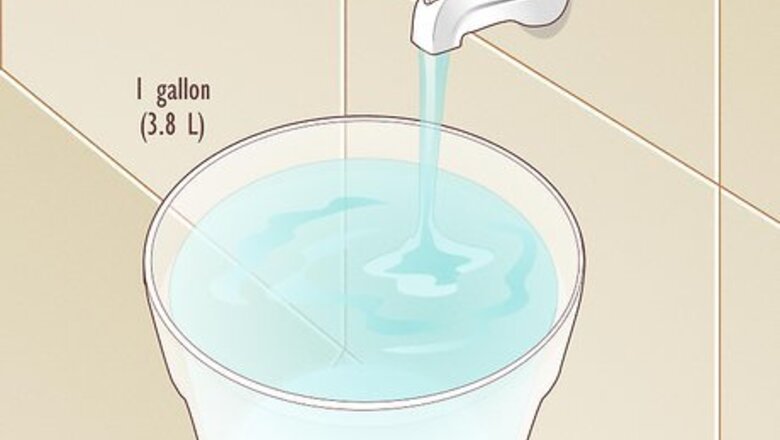
views
- Try pouring a gallon of water into the toilet bowl to manually flush it. If it doesn’t work, the problem might be inside the tank.
- Pour a bucket of water into the toilet tank up to the water line and press the lever or button to flush the toilet.
- If your toilet still won’t flush, it may be clogged, the water level in the tank may be low, the lift chain may be broken, or the rubber flapper may not be sealing properly.
Pouring Water into the Toilet Bowl
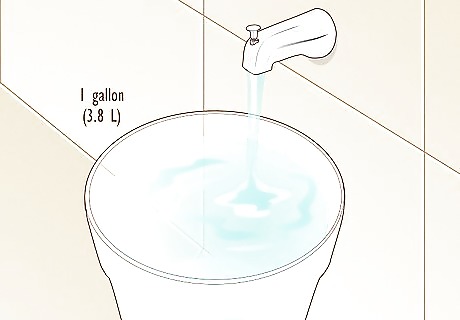
Fill a bucket with at least 1 gallon (3.8 L) of water. The exact amount of water you may need to use depends on the size and age of your toilet—newer toilets should flush with 1 or 2 gallons (3.8 or 7.5 L), but older toilets might need 3 to 5 gallons (11.3 to 18.9 L) of water in order to flush. There also might be a sticker on the inside of the toilet that has the amount of gallons/liters of water you need.
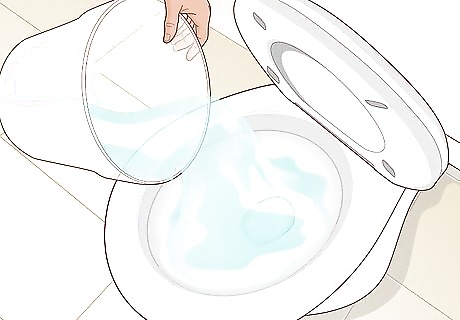
Pour the bucket of water into the toilet bowl. Start by pouring slowly, then increase the speed as you go. Pour the rest of the water from the bucket into the bowl quickly and wait for the waste to flush down automatically. If necessary, pour another bucket of water into the bowl until it’s completely free of waste. If your toilet still isn’t flushing, continue on to the next method or call a professional to diagnose and fix the issue.
Pouring Water into the Toilet Tank
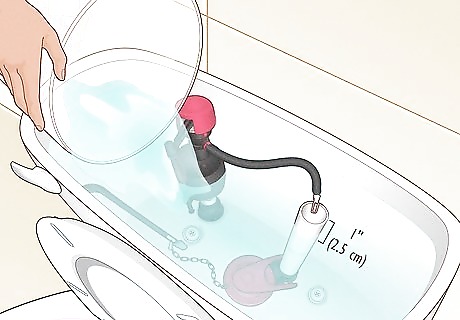
Pour water into the toilet tank to the water line or 1 in (2.5 cm) under the edge. Open the toilet tank lid. The amount of water you need to add varies depending on the model of your toilet. Most toilets will have a mark inside of the tank where the water level should be. If yours doesn’t, the water level should be 1 to 2 in (2.5 to 5 cm) below the open overflow pipe inside the tank.

Replace the lid and flush the toilet using the handle or button. After putting the toilet tank lid back on, flush the toilet by pressing the lever on the side or the button on the top of the lid. You can also flush by pouring at least 1 gallon (3.8 L) of water into the toilet bowl. If your toilet is automatic or uses both electricity and water, adding water to the tank may cause the toilet to overflow. If your toilet uses an electric pump system, it may best to call a professional plumber instead of trying to fix it yourself.
Pulling and Fixing the Rubber Flapper
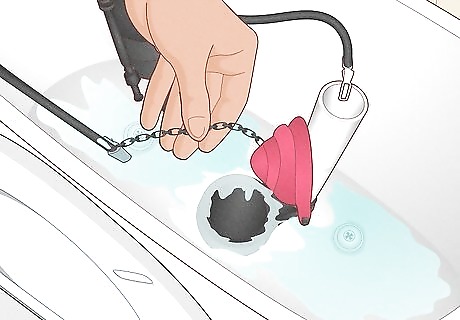
Check for connection problems between the handle and the flapper. If you’re still having trouble flushing the toilet, check the lift chain that connects the handle and the flapper. Sometimes the chain can get disconnected, which prevents the toilet from flushing. If the chain is disconnected, grab the loose end and slide a link onto the hook at the end of the handle arm. If the lift chain is broken, order a new one for your specific toilet model and hook the new one to the flapper and the handle. When you flush the toilet, the handle arm pulls the flush chain and lifts the flapper, which allows water to flow into the bowl from the tank. Optional: Turn off the water supply by turning the valve behind the toilet clockwise. With the water supply turned off, drain the water by pulling up on the rubber flapper at the bottom of the toilet tank. If lifting the flapper doesn’t drain all of the water from the tank, remove as much as you can with a cup, then absorb the rest with towels.
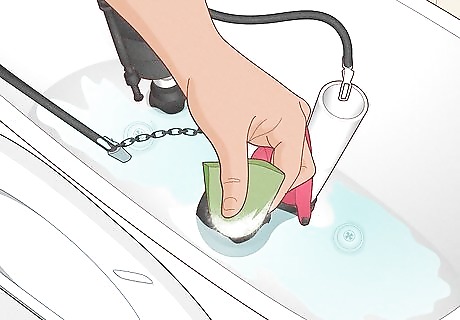
Scrub off any mineral deposits on the rim of the flapper’s seat. Lift the flapper and wipe your finger around the rim of its seat. If you feel any buildup, scrub the rim with a mineral deposit cleaner and nylon scrubbing pad. Try not to use steel wool or any other abrasive material. Mineral deposits or other buildup could prevent the flapper from sealing. If the flapper isn’t worn, turn the water back on, flush the toilet, and see if cleaning the rim solved your problem.
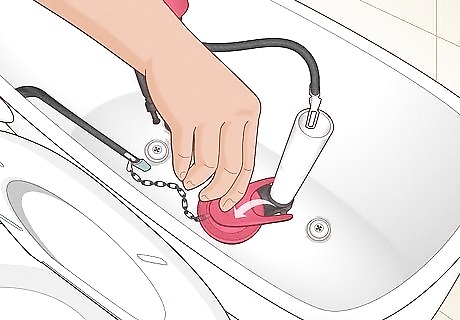
Reseat the rubber flapper over the opening at the bottom of the tank. When the flapper is down, it should make a tight seal, which keeps water from entering the bowl. If the rubber flapper isn’t properly sitting over the top of the opening in the base of the tank, reseat it, and water should start flowing back into the tank. If the chain came loose, it might have gotten stuck under the flapper and prevented it from sealing properly. If the flapper is worn and won’t sit properly you may need to replace it. If your toilet still won’t flush or flushes weakly after replacing the rubber flapper, you might need to adjust the water level or call a professional plumber.
Plunging a Clogged Toilet

Turn the water supply valve clockwise and wait for the bowl to drain. If your toilet needs to be unclogged, the bowl might have filled to a dangerously high level. Find the supply valve behind the toilet and turn it clockwise to shut off the water. After about 10 minutes, some of the water in the bowl should drain and you’ll be able to plunge without worrying about toilet water spilling out. To be on the safe side, spread old towels on the floor around the toilet to keep the water from making a mess in your bathroom.
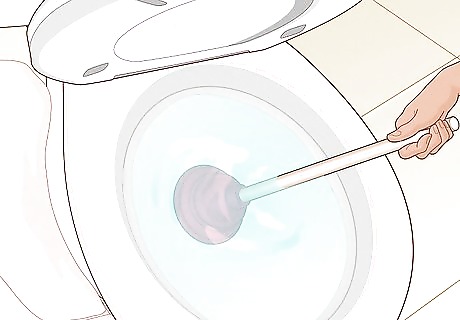
Place the plunger over the drain and gently push down one time. The plunger’s bell is filled with air, and a hard first plunge might splash toilet water out of the bowl, especially if it’s overfilled. Position the plunger over the drain at the bottom of the toilet and push down gently to release the air from the bell and form a tight seal around the drain. For best results, use a plunger with a flange extension, or an extra ring of rubber that extends from the bell. Flange plungers make a better seal and are more effective than bell plungers.
Add hot water to the bowl if the plunger isn’t submerged. Since you’ve turned off the water, the bowl might become empty even though the drain is still clogged. The plunger will only work if it’s submerged, so you might need to fill a bucket with hot water and add it to the bowl. Hot water will also help loosen up the clog, but make sure it’s not boiling—if the water is too hot, it could melt the wax ring at the base of your toilet and create a leak.
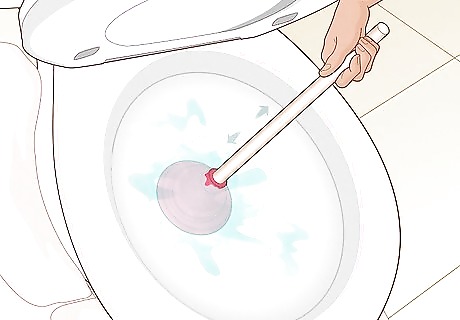
Plunge 15 to 20 times with quick, repetitive thrusts. After a gentle first thrust, plunge vigorously and quickly around 15 to 20 times. Keep your plunger on the drain at the bottom of the bowl to preserve the seal and force water in and out of the clogged drain. You should feel resistance until the clog is released.
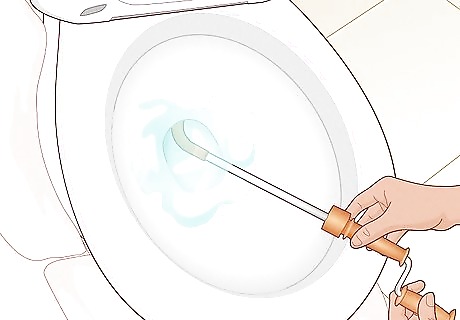
Snake the toilet if plunging wasn’t successful. Usually, 15 to 20 vigorous thrusts with a flange plunger is enough to clear a toilet clog—listen for a gurgle and watch to see if the water begins to drain. If plunging doesn’t do the trick, get a household plumbing snake at the hardware store, and use it to clear the clog. To use a snake, insert the hooked end into the toilet drain and turn it clockwise down the drain pipe until you encounter resistance. Keep turning it clockwise to hook the obstruction, then pull the snake out of the drain. Have a trash bin handy so you can easily dispose of any waste you pull out of the drain.
Adjusting the Water Level
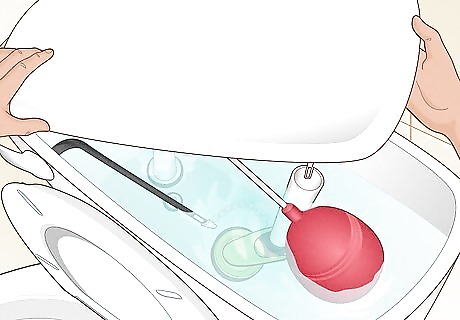
Remove the tank lid and check the water level. Most toilets have a line inside the tank where the water level should be. If yours doesn’t, the water level should be 1 to 2 in (2.5 to 5 cm) below the open plastic overflow pipe inside the tank. When the tank is full and stops running, the water level should be around the line. If the level is too low, the toilet might not flush or the flush will be weak. If it’s too high, water can spill into the overflow pipe and the toilet will keep running.

Adjust a ball-and-arm float by gently bending the rod. Look inside the tank for a rubber ball that floats on the end of a rod. If you see one, carefully bend the rod up or down so that the rubber ball is at the same height as the water fill line. For instance, if the water level is around 3 inches (7.6 cm) below the line, carefully bend the rod up so that the rubber ball is the same height as the line. Lifting the ball should engage the fill valve and cause water to run into the tank.
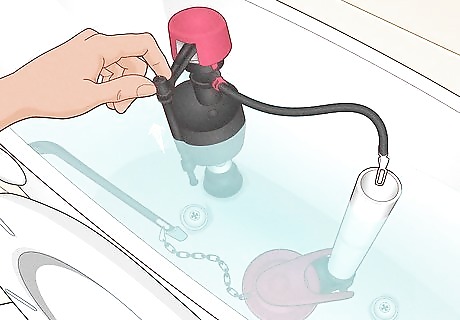
Raise the float cup if your model doesn’t have a ball-and-arm float. Check for a tube sticking out from the bottom of the tank (the fill valve) with a wide cylinder part (the float cup). Adjust the water level by rotating the small knob on the side of the tube, turning the plastic screw on the body of the float, or moving the release clip at the bottom of the fill valve up or down. If you’re not sure how to adjust your float cup, find your toilet’s brand and look online for specific instructions. You might also see a manufacturer’s mark on the float cup or on the tube it’s attached to—check the manufacturer's website for instructions or troubleshooting tips.

Flush the toilet to see if you’ve solved the problem. After adjusting the water level, press the handle and see if the toilet flushes. If it still won’t flush after troubleshooting the flapper, addressing any clogs, and adjusting the water level, you might have an issue that requires a professional plumber.
Flushing a Dual Flush Toilet
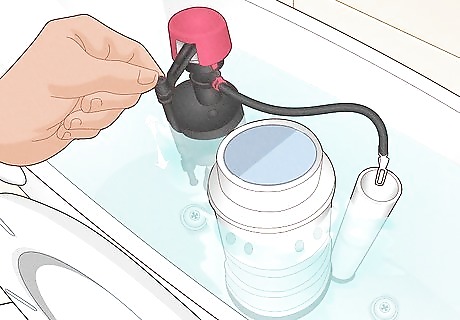
Try adjusting the water level first. Check the water level and adjust the water level as you would for a standard toilet. Remove the tank cover and find the tube with the wide cylindrical float cup. Depending on your model, rotate a small knob, pull a clip, or adjust a plastic screw to move the float cup higher or lower. After adjusting the float cup, see if the toilet will flush. If it doesn’t, try repairing or replacing the flush and fill valves. While they conserve energy, dual flush toilets may be more complicated than standard toilets. If you’re not sure about attempting repairs on your own, call a plumber.

Turn off the water supply before inspecting the valves. Before attempting to repair a dual-flush toilet, you’ll need to find the valve behind the toilet and turn off the water supply. After turning off the supply, pressing one of the flush buttons might drain water from the tank. If it doesn’t, use a cup and towels to remove water from the tank. It’ll be easier to work without water in the tank. The water also needs to be off when you remove the flush and fill valves.
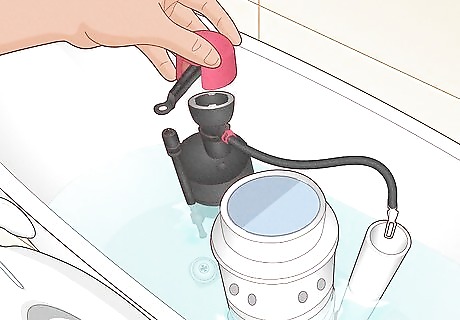
Remove the fill valve cap and flush away any debris. When you remove the tank lid, you’ll see 2 tube-shaped canisters sticking out from the bottom of the tank. The tube with 2 flush buttons at the top is the flush valve, and the other is the fill valve. Rotate the top of the fill valve counterclockwise, then gently pull up to remove it. For some models, you may have to unhook a flexible refill tube or arm that connects the flush and fill valves. Once the cap is removed, rinse it in the sink under warm water. Then place your hand over the fill valve (inside the tank), and slowly turn on the toilet water supply. Turn on the supply just enough that water flows through the valve without spraying all over the place. Buildup in the fill valve could be causing the issue. If you see any deposits after flushing the fill cap and valve, scrub them away with a toothbrush designated for cleaning.
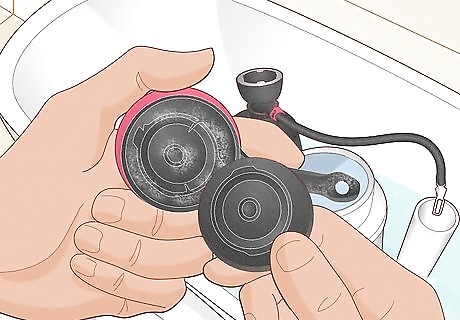
Inspect the fill valve’s washer, and replace it if necessary. Turn the toilet water supply back off after flushing the valve. Look under the top part of the fill valve that you’ve removed from the tank. Inside is a washer—make sure it isn’t cracked or worn. If the washer is worn or broken, replace it. Carefully pry the washer out with a flat-head screwdriver, then slide the new washer into place. If you know your toilet’s manufacturer and model, you might be able to order the right washer from them. Otherwise, you may be better off replacing the fill valve.
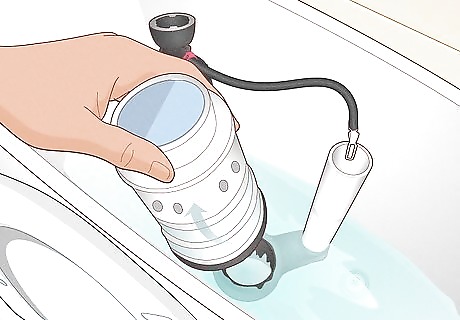
Remove the flush valve if the fill valve is problem-free. If you cleaned and inspected the fill valve and found no problems, the flush valve might be the issue. You should be able to remove the flush valve by rotating it counterclockwise (usually just a quarter turn) as you lightly apply downward pressure. Lift the valve upward when you hear a click or feel it disengage from the base. Look under the flush valve and find the silicone seal. The silicone seal does the same job as a standard toilet’s rubber flapper. Ensure it’s seated tightly in the underside of the flush valve, and check it for damage. Replace the flush valve if it’s worn or broken.

















Comments
0 comment